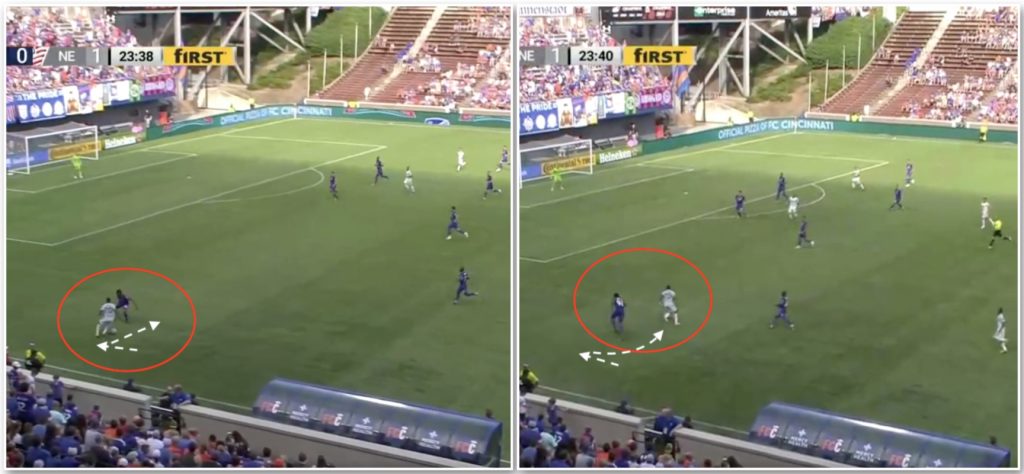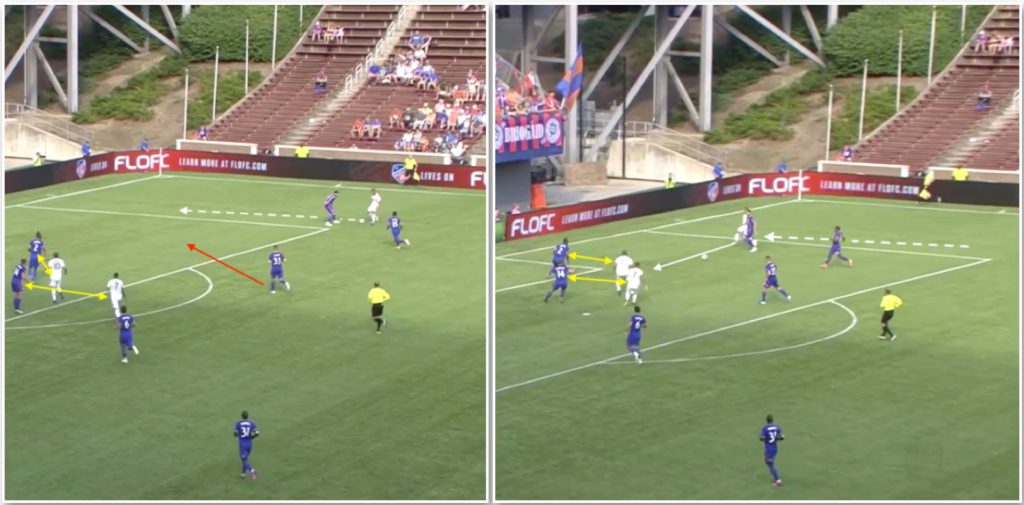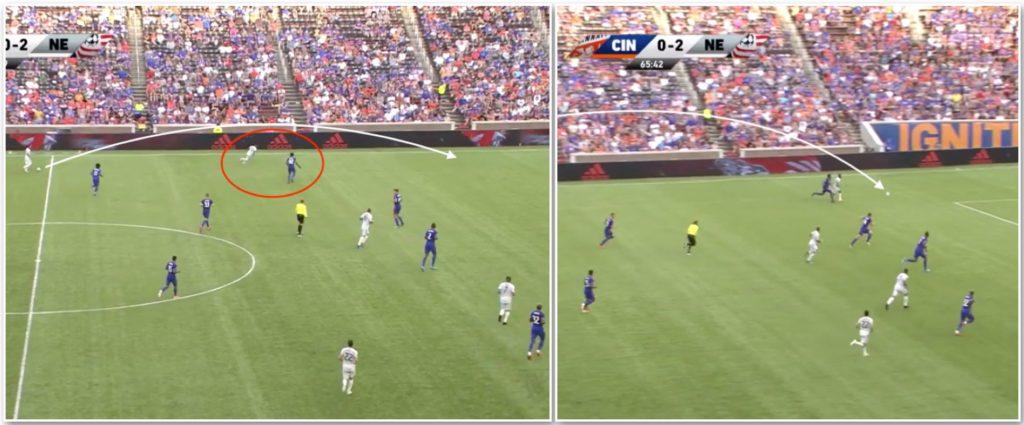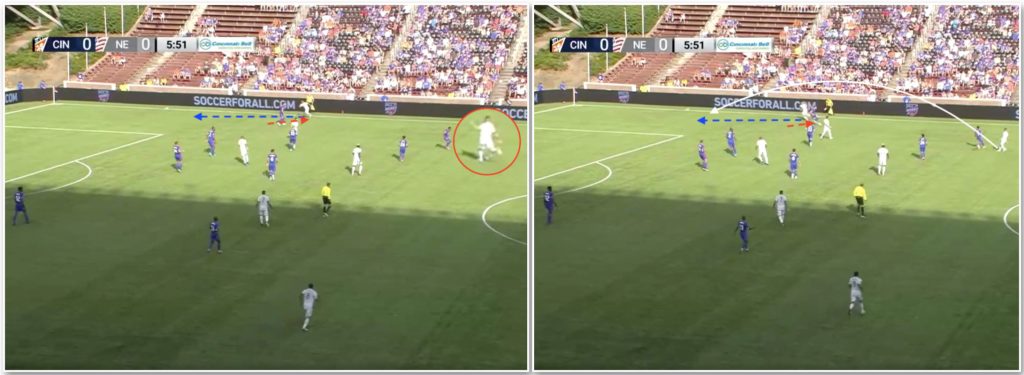There are many things that are “wrong” with this FC Cincinnati team. The MLS basement dwellers are not without talent, yet it is tied for last in goals scored and dead last in goals against. It would be impossible to outline every problem facing interim coach Yoann Damet and the Orange and Blue. Against the New England Revolution on Sunday, I put the defensive concerns in two major categories: between the lines and individual defending.
Defending Between the Lines
Defending between the lines means not allowing the opponent to receive the ball in front of one of your “lines” of defense, and behind another, with space to turn and operate. An example would be in a 4-2-3-1, allowing an opponent to receive the ball in front of the line of “2,” but beyond the line of “3.”
The number of times FCC struggles to defend these spaces is astounding. In Sunday’s match, FCC defended in a 4-4-2, meaning the space between the lines was in front of the back 4 and behind the midfield, or in front of the midfield and behind the front two. Players like Wilfried Zahibo and Diego Fagundez had a field day receiving the ball just in front of Caleb Stanko and Leonardo Bertone but well beyond Frankie Amaya and Fanendo Adi. Similarly, Carles Gil and Gustavo Bou made a living out of receiving the ball in front of Nick Hagglund and Kendall Waston but just beyond Stanko and Bertone.
This allowed them to break down the defense and create numerous scoring opportunities like the one:

Zahibo took up the space just behind Adi and Amaya as the Revolution moved the ball from right to left. At this point, he was already in dangerous space between the lines. Bou checked from behind the midfield to this same space to receive a pass, pulling Bertone wide with him. Bou fed Zahibo, who had loads of space to dribble forward and find a defense-splitting pass in behind Alvas Powell.
The way to solve this problem is to compress the space between the lines by tracking runners as the ball moves. In this instance, Adi was pressing the ball, and it moved from right to left, causing Amaya to move to press. Adi could have immediately dropped in behind Amaya, effectively shrinking the space between the forward and midfield lines and screening Zahibo. Alternatively, Bertone could have moved forward to press Zahibo. Similarly, as Bou checked off of the back line into the midfield, a defender needed to follow him or communicate to a midfielder to drop in, effectively shrinking the space between the back and midfield lines.
In doing this, defenders need not be touch tight but simply need to be close enough to the runner that if they were to get the ball, the defender can move to close down space before he can turn.
FCC failed at this principle time and time again:

Here, as the ball pulled from the left sideline toward the center, Zahibo and Fagundez took up positions between the lines. Fagundez was easily found and had tons of space to turn and find Bou, operating between the center and outside backs. Once again during the initial build-up, Stanko should have been accounting for Zahibo, leaving either Allan Cruz or Adi to account for Fagundez. Cruz was pulled back on Gil (though this could possibly have been left to Waston), and thus Adi needed to drop.
Individual Defending
It seems like the FC Cincinnati players lose a lot of their individual defending battles, getting beat too easily. Statistically speaking the Revolution were successful on 6 out of 18 of their take-ons. This doesn’t seem terrible until you isolate take-ons in the defensive third, in which case the numbers change to success on 4 of 7. This number only accounts for taking a player off the dribble and doesn’t even count the number of times defenders are beat with simple passes. Specifically, the FCC outside backs routinely get torched by opponents.
Alvas Powell:

and Mathieu Deplagne:

In both of these cases, each of the FCC outside backs was taken to task off the dribble without being able to so much as get a finger on the opponent.
Without finding a way to simply play better defense, the fix here is to always provide cover to the outside backs. That means that the FCC center backs would have to work to get across the field to get closer to the outside back, or as in the diagram above when both center backs have players that they are marking, one of the midfielders would need to drop into the space behind the outside back as a make-shift third center back.
Then, there’s the matter of getting beat with simple passes. Again, Powell:

And Deplagne:

In each case, the Revolution attackers didn’t do anything special. They just ran in behind our outside backs while their teammates played the ball over the top.
Neither of these problems is the whole issue, and neither is limited to just the players listed above. However, both of these issues are fixable with simple tactical adjustments and a bit of hard work on the part of the players on the field. Until then, the FCC faithful are going to keep seeing goals scored against their team, and the addition of one center back is not going to solve the problem.
@fccincytactalk (Brad Gough) for @CincySoccerTalk
Brad Gough is the former head coach of the Cincinnati Lady Saints and Cincinnati Christian University.

















